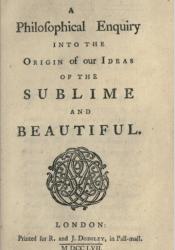Edmund Burke: The Sublime and Beautiful
Edmund Burke (1729-1797) was an Irish statesman and philosopher known for his influential treatise, A Philosophical Enquiry into the Origin of Our Ideas of the Sublime and Beautiful (1757). In the work, Burke discusses the grotesque, along with the duality of horror and sublime, all associated with the Romantic and Gothic movements. Burke proposes beauty stimulates love: "I call beauty a social quality; for where women and men, and not only they, but when other animals give us a sense of joy and pleasure in beholding them (and there are many that do so), they inspire us with sentiments of tenderness and affection towards their persons;" (Burke 115). In the same vein that beauty inspires tenderness, the sublime brings tention through horror: "Whatever therefore is terrible, with regard to sight, is sublime too, whether this cause of terror be endued with greatness of dimensions or not; for it is impossible to look on anything as trifling, or contemptible, that may be dangerous" (Burke 131).
The sublime is triggered by extremes, which Burke mobilizes into stressing the importance of perceiving possible threats. As Doody and Milberger point out in their "Indroduction," these threats can be "hidden emotional and social causes" which "bring about unanticipated and even undersired effects" (17). These undesired effects are a direct cause of the sublime, which inform the way characters behave and function in their given society. Often, characters like Sir James Powis and Lord Darcey are insistent on power and control, an observable response to these "unanticipated and even undesired effects" (Doody and Milberger 17). What power grabs will we see in Northanger Abbey among characters who struggle to balance the extremes of horror and pleasure? Perhaps we can see the novel function as a study or observation of human response to the nature of duality.
Burke, Edmund. A Philosophical Enquiry into the Origin of Our Ideas of the Sublime and Beautiful. Printed for R. and J. Dodsley in Pall-Mall, 1757.
Doody, Margaret, and Kurt Edward Milberger. “Introduction.” Barford Abbey, Broadview, 2021, pp. 9–21.

